Archive for the ‘public_art’ Category
New animation available online
In the midst of being thrown out of my home by NYC and staying with friends and family, it took me a while to assemble some documentation of the recent commission I completed for a festival in Mexico City:
http://www.ambriente.com/carreta_nagua/
The animation “Arbol que nace torcido, nunca su rama enderece” (Tree that is born twisted, never straightens) is available online:
http://www.ambriente.com/carreta_nagua/animation.php
The animation is about 8 and a half minutes long and features El Chapulin Colorado and Ultraman discussing the effects of globalization, immigration and personal loss due to cultural transitions. The script is based on my parent’s current reality as they move back to Nicaragua after 45 years in San Francisco, CA. The animation was featured on a rickshaw as passengers were offered a tour of the colonial park Alameda Central in the historical center of Mexico City. The title of the project is “Carreta Nagua, Siglo 21”, a description of the project and explanation of the title is also available online as well as plenty of images:
http://www.ambriente.com/carreta_nagua/
The tour and animation generated excellent discussion and lots of local press, primarily on television and is still on view at the museum – Laboratorio Arte Alameda – http://www.artealameda.inba.gob.mx/
So if you are in Mexico City, please stop by to see the exhibition. It’s an excellent exhibition that I discussed in my blog while in Mexico City:
TRANSITIO at Laboratorio Arte Alameda
Carreta Nagua Siglo 21, day 5
El Parque Alameda Central is filled with people on Sundays. Musicians, merchants, families, tourists and this Sunday was a beautiful clear day, perfect for a nice tour through the park on a rickshaw. Most people questioned the fact that the ride would be free, but once a few people were convinced many more waited to be taken for a ride and watch the animation. People seemed to enjoy the animated narrative that featured El Chapulin Colorado and Ultraman discussing personal changes due to migration.
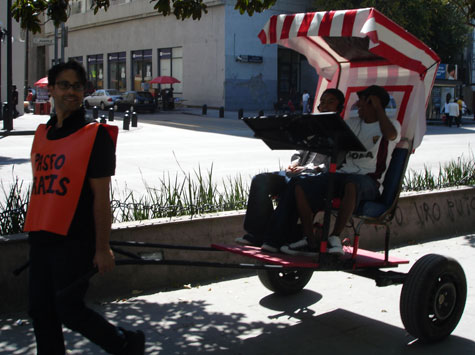
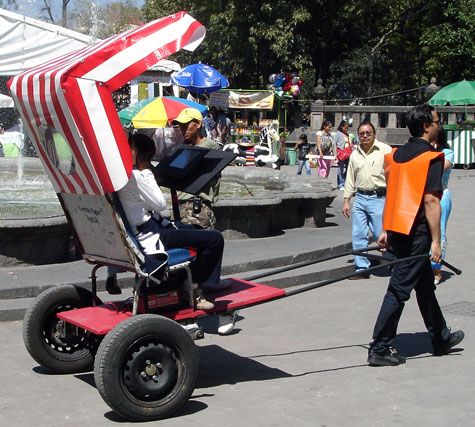
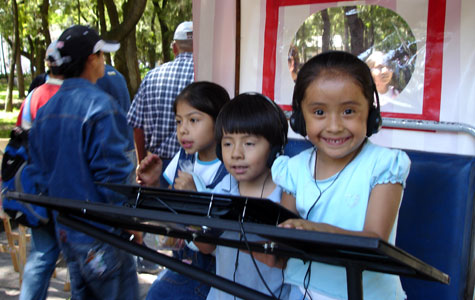
Carreta Nagua Siglo 21, day 4
The cart is finalized with rooftop, panel for the display, painted and ready to take people on tours of the park.
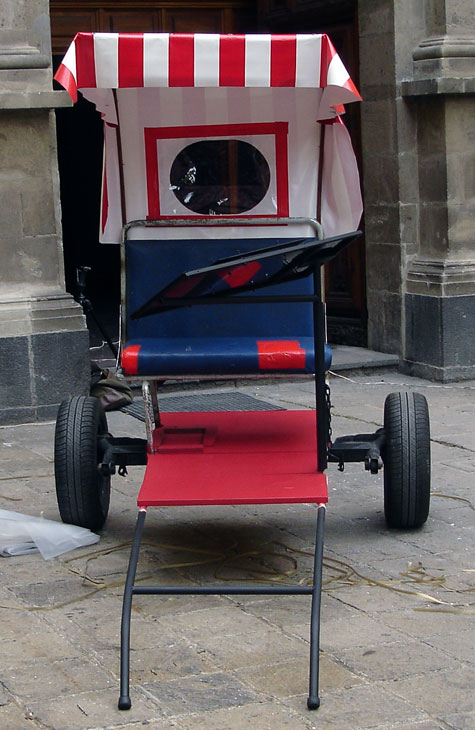
Carreta Nagua Siglo 21, day 3
Putting the final pieces of the frame work of the cart, before painting and adding all the details.
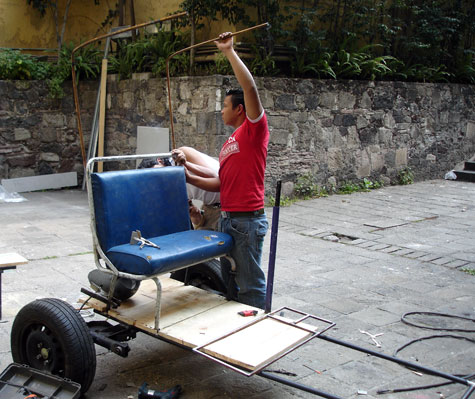
Carreta Nagua Siglo 21, day 2
I had a young crew of three boys to help me assemble the cart through the weekend. Saturday morning I took a trip with their boss, a Spaniard named Hector who runs a fabrication company that primarily does exhibition production for large media companies such as Sony, but prefers to do production for cultural institutions, they just don’t pay the bills. We drove to his shop with a couple of his employees to gather tools and materials. Returned to Laboratorio Arte-Alameda and immediately got to work. It was a late start and I only had the three guys that day and Sunday. By the late afternoon the cart began to take shape. We completed the basic structure, installed the bus chair and resolved a few questions. In the early evening it began to poor so we stopped to continue on Sunday.
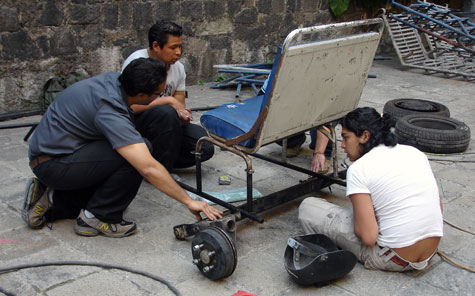
Discussing the joining of the axle to the steel tubes that would make the primary structure.
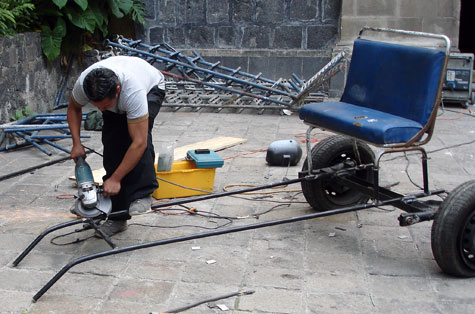
Cleaning up the welds.
Carreta Nagua Siglo 21, day 1
Friday, October 5th was the first day on getting started in assembling the physical component of my TRANSITIO commission for “impolis”, one of a series of curatorial components that make up TRANSITIO_MX02, the second installment of this new media festival in Mexico City.
I’m building a rickshaw that will tour people around a park in the historical center of Mexico City, Parque Alameda. As people take a ride on the rickshaw that I will pull, they will watch an animation that I’ve been creating over the last few months. Carreta Nagua is an old folk tale from Nicaragua, tale generally told to children when they refuse to go to sleep, because it’s a wagon (carreta) driven by death and pulled by two skeletal oxen, it makes a great deal of noise, as if chains were been dragged along the ground as it makes it way. When the Carreta Nagua arrives at ones home, the person is sure to die. It’s assumed that the tale, a very old tale shared amongst the indeginous people of Nicaragua, but also having many parallels throughout Latin America, is believed to have been established due to the slave carts driven by the Spaniards to take slaves to the mines. People taken by the carts would disappear, only to be seen again as corpses. The Spanish would take indeginous people to the mines to work, where they would wear away to die and be taken as corpses for burial. When indeginous people heard a cart, they would hide, the cart became a symbol of death.
The animation featured on the cart, on a panel that sits in front of the passenger is based on my parents. They left Nicaragua over 40 years ago, to work and establish a family and to give their children greater possibilities. Now they are returning to Nicaragua, but it’s an entirely different place than the one that they left. “La Carreta Nagua” is an allegory for the translocation of people, the leaving of ones culture, extended family, language – for greater means or opportunities / for economic reasons in a pancapitalist era. This is the personal or subjective or individual portion of globalization, not the corporate form of globalization, but the mass migration of populations due to highly subjective decisions by individuals.
So Friday was day one, when I was taken by Juan and Israel to “deshuesadores” – one translation might be skeleton cleaners, but really auto wreck dumps. The rickshaw needs an axle, tires, seats, a steel frame… all parts that can be found at an auto dump. I’d been concerned at how all this would come together, but it went smoother than I could have imagined. At our second stop we acquired nearly all the primary parts and at a fraction of the price that the curators had set aside for the project. One of my goals was to assemble this piece entirely from recycled parts and not to use new materials, so far so good. Here are a few shots documenting day one.
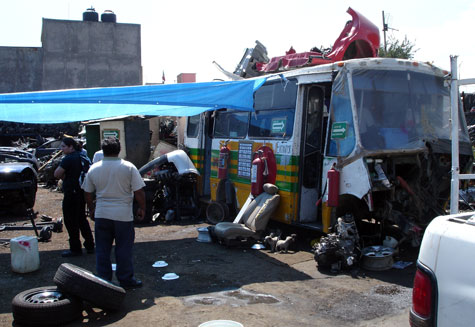
This auto wreck site revitalized an old bus as its office. To the right is the office and beyond is surplus of old and new cars and parts that can no longer function as designed.
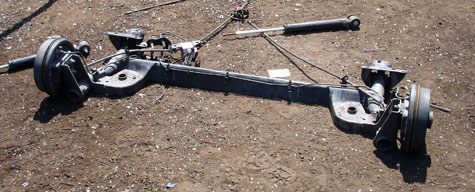
I showed a kid working the site a few drawings, explained what we were building and asked for specific parts and he pulled out an ideal axle, a unit nearly ready to go that would be wide enough to seat two above. We bartered down the price by leaving the shocks that were on the axle. Every single piece has a value.
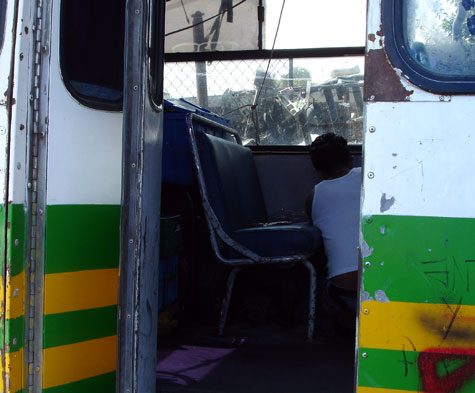
After we asked for seats, he showed us a few car seats, mostly bucket seats from recent cars, but they weren’t what I was looking for. I looked into the office and saw the bus seat near the backdoor and told the guys that were taking me around that that was what I was interested in and they said well, let them know. I did, they gave us a price, we haggled and we got it. Everything is for sale, event sections from the business office.
Their tire prices seemed high, so our driver suggested that we try a few tire repair places, such as the one below. Set up on a corner, one can pick up a new tire on the fly, such as the one below
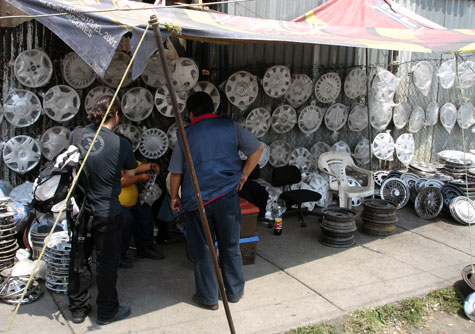
After a day that started with a long and crowded metro ride and continued into several hours of driving around Mexico City in increasingly terrific traffic and haggling for car parts, I was taken by Antonio, the exhibition administrator who took car of all the public art permits to a very old taco place in the town center. Then we had a couple tequilas on his deck overlooking Mexico City’s downtown.
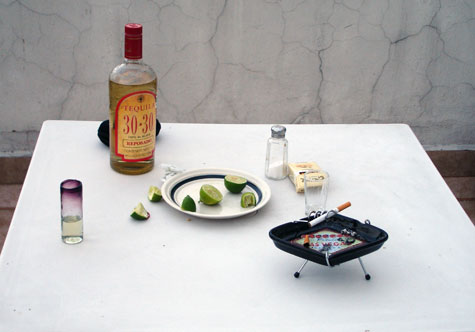
A view of Mexico City’s historical downtown from a 5th story deck
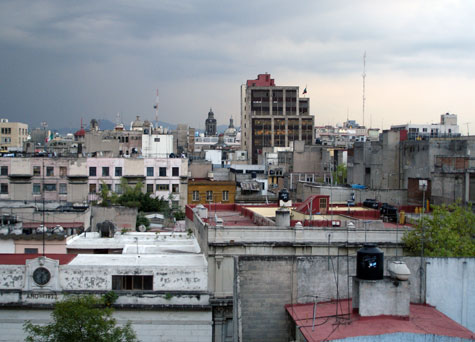
Presentity by Kabir Carter
Presentity by Kabir Carter was one of the most unique public art experiences that I’ve had in a very long time. This is primarily due to its honesty and subtleness. The project did not involve any spectacle, rather it was a highly private experience carried out in tourist center filled with activity.
A few weeks before the dates of the performance, Kabir emailed an invitation to be audience to Presentity. Eager to listen to Kabir’s work and spend time with the sound artist, I replied and he wrote back with a time and date and that I would receive a text with the exact location the day of the performance. It was all a bit mysterious.
On Saturday August 18th, I received the address – the back stairs of City Hall on Chambers. That afternoon I sat and waited for Kabir as firetrucks rushed by to the Deutsch Bank building where a fire exploded. There was one other guy who showed up and looked like an artist. Kabir showed up carrying three walki-talkis, he introduced us and we began to walk.
On Chambers we walked east, turned the corner at Centre Street and entered a very old subway elevator. We rode the elevator up and down twice, the first time with one other person, the second time, only the three of us and the performance began. Kabir manipulated the walki-talkis to create the electronic sound performance, we merely walked with him and listened as carefully as possible. We exited the elevator below ground, entered the subway station, walked through the tunnels, up the stairs and back onto Centre Street, walking adjacent to City Hall, listening carefully. Then crossed the street toward Pace University. Bent down to the ground to listen to the sounds resonating within the cavernous space below a steel grate.
Again we entered the subway, this time via a desolate subway entrance at the corner of Pace University, we walked through a long, empty subway tunnel. We exited the subway and the performance ended.
The walk and performance were a delicate intervention upon the City Hall area of New York City, I call it delicate because it was comprised of three individuals focused upon careful listening in a saturated space where focus is difficult to achieve.
I felt that the sound performance began a bit awkwardly, as if Kabir needed a bit of time to catch his rhythm. However the elevator was a highly successful tool for spatial transfer… I’m not sure how to put this. The elevator was very successful in creating the sensation that we were being taken to a different place, to a site within a site… to our own place, a private space shared between us three individuals but located within the City Hall Park area.
At first the most difficult element personally was negotiating between getting out of the way of pedestrian traffic and listening to the performance. But as we continued, the listening took presedence over the concern of allowing pedestrians by. Also as the performance continued the sound began to coalesce, there was meat to it, it sounded as a concert or performance and not merely noise trying to find its language.
Rhizome Commissions Program
In 2007, Rhizome will commission eleven new art works with fees ranging from $1000-3000. You can submit a proposal below, or read more about our submission and voting procedures.
New works of Internet-based art, Ten commissions will be awarded in this category. Submit at http://rhizome.org/commissions/2007/artist_proposal.php
Community project, Submit at http://rhizome.org/commissions/2007/community_proposal.php
All of the commissioned works will be exhibited on Rhizome.org and at a one-night event at the New Museum of Contemporary Art, as well as archived in the ArtBase.
Conflux 2007 Call for Proposals
Conflux 2007 will take place in Brooklyn again this September and we want you in it! The call for proposals is at http://confluxfestival.org and has all the information you need on how to participate. The online submission form will be live next week and the deadline for proposals is April 17. It’s a tight deadline, but the submission process is short & sweet and we look forward to receiving your proposals. The Conflux festival has been described as “a network of maverick artists and unorthodox urban investigators…making fresh, if underground,contributions to pedestrian life in New York City, and upping the ante on today’s fight for the soul of high-density metropolises.” At Conflux visual and sound artists, writers, urban adventurers and the public gather for four days to explore the physical and psychological landscape of the city. For more information about Conflux, check out the Conflux 2006 site at: http://confluxfestival.org/conflux2006/